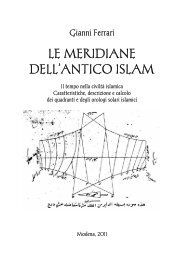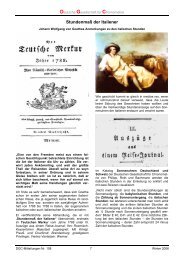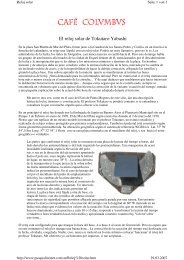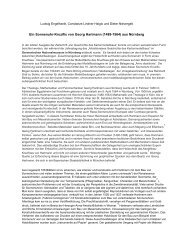International Gnomonic Bulletin - Gnomonica by Nicola Severino
International Gnomonic Bulletin - Gnomonica by Nicola Severino
International Gnomonic Bulletin - Gnomonica by Nicola Severino
You also want an ePaper? Increase the reach of your titles
YUMPU automatically turns print PDFs into web optimized ePapers that Google loves.
the Oak King falls to his darker aspect, the Holly King, God of the waning year..." 13 The<br />
days following Alban Heruin form the waning part of the year because the days become<br />
shorter.<br />
Ancient China: Their summer solstice ceremony celebrated the earth, the feminine,<br />
and the yin forces. It complemented the winter solstice which celebrated the heavens,<br />
masculinity and yang forces.<br />
Ancient Gaul: The Midsummer celebration was called Feast of Epona, named after a<br />
mare goddess who personified fertility, sovereignty and agriculture. She was portrayed<br />
as a woman riding a mare.<br />
Ancient Germanic, Slav and Celtic tribes in Europe: Ancient Pagans celebrated<br />
Midsummer with bonfires. "It was the night of fire festivals and of love magic, of love<br />
oracles and divination. It had to do with lovers and predictions, when pairs of lovers<br />
would jump through the luck-bringing flames..." It was believed that the crops would<br />
grow as high as the couples were able to jump. Through the fire's power, "...maidens<br />
would find out about their future husband, and spirits and demons were banished."<br />
Another function of bonfires was to generate sympathetic magic: giving a boost to the<br />
sun's energy so that it would remain potent throughout the rest of the growing season<br />
and guarantee a plentiful harvest. 6<br />
Ancient Rome: The festival of Vestalia lasted from JUN-7 to JUN-15. It was held in<br />
honor of the Roman Goddess of the hearth, Vesta. Married women were able to enter<br />
the shrine of Vesta during the festival. At other times of the year, only the vestal virgins<br />
were permitted inside.<br />
Ancient Sweden: A Midsummer tree was set up and decorated in each town. The<br />
villagers danced around it. Women and girls would customarily bathe in the local river.<br />
This was a magical ritual, intended to bring rain for the crops.<br />
Christian countries: After the conversion of Europe to Christianity, the feast day of<br />
St. John the Baptist was set as JUN-24. It "is one of the oldest feasts, if not the oldest<br />
feast, introduced into both the Greek and Latin liturgies to honour a saint." 16<br />
Curiously, the feast is held on the alleged date of his birth. Other Christian saints' days<br />
are observed on the anniversary of their death. The Catholic Encyclopedia explains that<br />
St. John was "filled with the Holy Ghost even from his mother's womb...[thus his]<br />
birth...should be signalized as a day of triumph." 16 His feast day is offset a few days<br />
after the summer solstice, just as Christmas is fixed a few days after the winter solstice.<br />
1 "Just as John was the forerunner to Jesus, midsummer forecasts the eventual arrival<br />
of" the winter solstice circa DEC-21.<br />
Essenes: This was a Jewish religious group active in Palestine during the 1st century<br />
CE. It was one of about 24 Jewish groups in the country -- the only one that used a solar<br />
calendar. Other Jewish groups at the time included the Sadducees, Pharisees, Zealots,<br />
followers of John, and followers of Yeshua (Jesus). Archeologists have found that the<br />
largest room of the ruins at Qumran (location of the Dead Sea Scrolls) appears to be a<br />
sun temple. The room had been considered a dining room <strong>by</strong> earlier investigators, in<br />
spite of the presence of two altars at its eastern end. At the time of the summer<br />
solstice, the rays of the setting sun shine at 286 degrees along the building's longitudinal<br />
axis, and illuminate the eastern wall. The room is oriented at exactly the same angle as<br />
the Egyptian shrines dedicated to the sun. Two ancient authorities -- the historian<br />
Josephus and the philosopher Filon of Alexandria -- had written that the Essenes were<br />
sun worshipers. Until now, their opinion had been rejected <strong>by</strong> modern historians. 19<br />
Native Americans:<br />
The Natchez tribe in the southern U.S. "worshiped the sun and believed that their<br />
ruler was descended from him. Every summer they held a first fruits ceremony." Nobody<br />
was allowed to harvest the corn until after the feast. 2
















